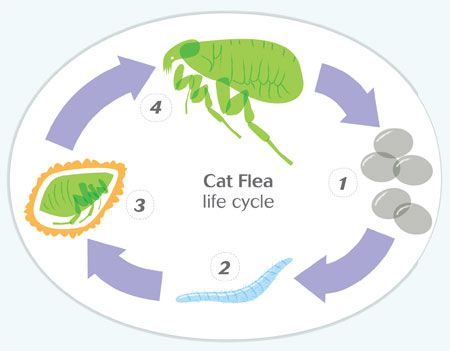Feeling burnt out on fleas? Try these tips for client compliance
Weve combed (see what we did there?) through our archive to bring you the best reader-submitted tips to combat fleas.
Fleas. You talk about them all the time, and there's nothing new to say, right? Your clients listen to your spiel, kinda nod, and then leave, maybe with prevention, maybe not. If you're feeling like your flea prevention talk could use some refreshing, check out these tips rounded up from you, our readers.
Don't see something you use all the time? Send it to us! Email firstline@ubm.com. We'll pay $50 for every tip we publish.
A helping hand may increase parasite preventive compliance
Some pet owners are uncomfortable applying flea preventives to their pets. To ensure they're applying it properly, I have them apply a starter dose in the exam room. I hold their pets and have the owners open the applicator and apply the dose onto the skin. Telling them a simple "good job" afterward leaves owners with the confidence to repeat the application by themselves the next month.
Dr. Natalie H. Hall
Atlanta, Georgia
Are fleas falling from your clinic's ceiling?

Are you tired of the same ol', same ol' with veterinary clients about why they should really use flea preventives on their pets? It gets tedious, especially if they aren't receptive to your message. If so, try doing what staff at PetWorks Veterinary Hospital in Overland Park, Kansas, does and make it visual.
Their plan: Take an illustration of a flea, print out a lot of copies (40 to be exact, more on that later), cut them out and laminate them, and then hang the completed fleas from the ceiling in the reception area.
Why 40? Not only is it more visually striking than a few fleas stuck to a bulletin board, a single female flea can lay between 40 to 50 fleas per day. Giving clients a concrete example of the production capabilities of a single flea, let alone however many fleas really are on their pet, is a good motivator to get the conversation started. Because everyone knows fleas can get out of hand fast.
PetWorks receptionist Cindy Harris says the promotion has been so successful that the hospital needed to restock flea preventive way earlier than anticipated.
Click here for a printable flea image, if you need one.
Use loyalty cards to give parasites the 1-2 punch
Punch cards help keep heartworm and flea-and-tick prevention affordable for clients of the Animal Wellness Clinic in Michigan City, Indiana. "When clients purchase a dose, we punch their cards," says practice manager Sandy Haynes. "After 12 months of heartworm preventive purchases, clients receive a month of free prevention. After six months of flea-and-tick control purchases, clients receive one free dose."
The payoff is that clients come to understand the importance of keeping pets on parasite prevention. "Plus, they love the fact that we went to the extra effort for those who can't afford to purchase the larger amounts," Haynes says. To comply with EPA regulations, Haynes got extra product inserts from the company representative to hand out with any single doses sold. Clients are happy, pets are protected, and rules are followed-that's parasite prevention perfection.
Natural flea repellents-there's a sample script for that
Use this script from Jenna Stregowski, RVT, when clients have questions about the natural products they use for their own healthcare.

shutterstock.com
Ms. Jones: What natural products can I use on my pet to repel ticks and fleas?
You: I understand your desire to use natural products for your pet. It is true that some natural products and supplements may be beneficial to pets when given under the supervision of a veterinarian. However, when it comes to fleas and ticks, natural products and home remedies simply aren't effective. In fact, some natural ingredients can do more harm than good. Steer clear of feeding your pet garlic and herbs, as these can be toxic. Also, avoid applying topical essential oils, which can irritate skin and overwhelm your pet's hypersensitive sense of smell.
Please be sure to contact us before using a natural product or home remedy on your pet so we can make sure it is safe first. For fleas and ticks, it's best to choose a product that has been proven through lots of research to be safe and effective. I'd be happy to go over the flea and tick prevention products recommended by our veterinarian.
Client handout: If you've been infested
Tell your pet owners not to panic and follow these tips to handle a dreaded flea infestation. Share your sympathy with pet owners-and use this handout to make sure they have all the information they need to protect their homes (and pets, of course!) from fleas. It's particularly useful to help explain the action steps to take after a flea infestation.
Give clients these tips on topical flea and tick products
Check out these tips from Pet Poison Helpline to assuage client's worries about using topical flea-tick preventives.
Incident rates are very low. The EPA found that the overall incident rate for flea and tick products was about 16 incidents per 100,000 applications. The incident rate for cases with a major or fatal outcome was about one in 200,000.
Treatment can cause itching. Using fast-acting topical flea and tick medications can cause itching or brief irritation at the application site. Pets' skin might twitch, or they may fidget, roll around, and scratch in response, but this reaction usually subsides quickly.
Paresthesia can develop. A small number of treated pets-particularly smaller breeds-may experience paresthesia, or a tingling at the application site. Clinical signs are those similar to the itching described above. These incidents are rare and are usually mild and self-limiting, but do account for a large number of the reported incidents.
Most adverse reactions are caused by operator error. For example, a pet owner might mistakenly apply a dog product to a cat or miscalculate the dose.
To get in front of infestations, try these tips from Chris Feaster, VMD, and Haley Switzer, veterinary assistant at Valley Veterinary Clinic in Buckingham, Pennsylvania.
Back to the basics: Flea life cycle

The life cycle of the flea is the most basic thing we can teach clients and one of the most important because, unfortunately, not one product available can terminate fleas at every life stage.
A quick refresh: There are four stages to the flea life cycle: egg, larva, pupa and adult. The former three actually make up approximately 95% of the flea population. So, make sure clients understand that killing adult fleas once their home is infested is not enough.
It helps to put things in basic terms. If an infestation occurs it can easily take at least three months, if not longer, to treat. Not only does the pet need to be properly treated, but the local environment (i.e., the home) needs to be treated as well. This means lots of cleaning and washing.
When cleaning, remind clients of the importance of vacuuming-not only the areas that we see but also under furniture, in the cracks of the floorboards and in-between couch cushions. Of course, vacuuming will not kill the fleas or eggs. The little creatures are resilient and will crawl right back out into the environment, on the hunt for a host again. Tell clients fleas love dark, warm and moist environments.
Flea eggs can and will fall off of their host, hatch, and can remain in the pupa stage for up to eight months, or until environmental cues trigger them of a possible nearby host. From there they will mature into an adult, and the infestation will continue. Remind clients that their yard may need to be treated as well, since this is usually where the fleas originated.
Emphasize that infestation = $$$$
Altogether, the cost of treating a flea infestation can add up. There is the cost from treating the house and yard for months, not to mention the time spent cleaning. Win clients over with one line: Although the cost of some preventive products can seem like a lot, in the end it will be much cheaper than treating an infestation.
Most people don't know that fleas can be harmful to their pets' health. It is incredibly, uncomfortably itchy to be covered in fleas. For humans who've never been troubled by fleas, liken them to bed bugs-except these bed bugs bite you all day, every day, not just when you sleep.